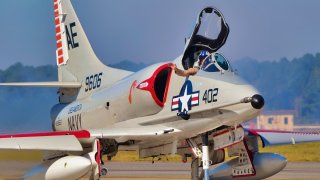The U.S. Navy's A-4 Skyhawk Was Armed to the Teeth
For more than two decades, approximately 3,000 A-4 Skyhawks were produced. Many nations acquired the American-made platform, including Israel, Argentina, Kuwait, New Zealand, Indonesia and Malaysia. The Navy eventually relegated the platform to retirement in the early 2000’s, however, the A-4 maintains its honorable service history.
Summary: The Douglas A-4 Skyhawk, a marvel of military engineering introduced in the early 1950s, has etched its name into aviation history with a legacy of versatility, reliability, and effectiveness. Dubbed the "Tinker Toy" for its compact frame, the Skyhawk was developed to supersede the Douglas AD Skyraider as the primary attack aircraft for the U.S. Navy and Marine Corps. Its design boasted a significant achievement—coming in under the weight limit set by the Navy, yet offering robust performance with a single turbojet engine, achieving speeds near the sound barrier. Renowned for its agility and formidable armament, including 20mm cannons and a versatile loadout capacity, the A-4 played a pivotal role during the Vietnam War, demonstrating the Navy's strike prowess.
Why the A-4 Was Such a Legend
The Vietnam War-era A-4 Skyhawk remains one of the most respected airframes among military experts and aviation buffs alike. When the U.S. Navy and Marine Corps first introduced the platform in the early 1950’s, the A-4 was intended to replace the Douglas AD Skyraider (A-1) as both service’s attack aircraft. The single-seat subsonic carrier-capable platform was often dubbed “Tinker Toy” due to its small frame. Despite its size, the Skyhawk truly exemplified the Navy’s strike capabilities during the Vietnam War.
The history of the A-4:
When then-chief engineer of Douglas (now McDonnell Douglas) first claimed that he could construct a new jet attack bomber weighing half the amount that the Navy required, critics were highly skeptical. Ultimately, however, Douglas did manage to produce the Skyhawk weighing under 10,000 pounds. Other than this unique feature, the A-4 resembled the typical post-WWII design, possessing a single turbojet engine in the rear fuselage, a low-mounted delta wing and tricycle undercarriage. The sole 7,200 lb-thrust Curtiss-Wright J65 turbojet engine that powered the airframe enabled the Skyhawk to fly at a maximum speed of roughly 670 miles per hour (just shy of the speed of sound).
Although the Skyhawk was not the fastest airframe out there, it was still quite agile. Perhaps more significantly, the A-4 was armed to the teeth. Each airframe was equipped with a pair of 20mm Colt Mark 12 cannons with 100 rounds per gun. Additionally, a large array of rockets, bombs and missiles could be carried on a hardpoint under the platform’s fuselage centerline.
Operational history and exports:
The Skyhawk’s small frame enabled it to be operated on older and smaller World War II-era aircraft carriers. Some of these aging ships were still being used by smaller navies in the 1960’s. New and larger fighter platforms like the F-8 Crusader and F-4 Phantom II could not be accommodated on these carriers due to their size. Although the A-4 was less capable than either platform, it could be of service on these smaller ships.
During the Vietnam War, the A-4 Skyhawk platform served as the U.S. Navy’s primary light attack aircraft until the A-7 Corsair II was introduced. In fact, some of the first and last strikes and bombs launched by American forces during the conflict were fired from Skyhawks. In the second half of the 1950’s, the A-4 became the first platform to be deployed abroad armed with the AIM-9 Sidewinder. Notably, 2008 presidential nominee and late U.S. Senator John McCain flew one of the A-4s that were shot down during the war, resulting in his five-and-a-half-year experience as a prisoner of war in the notorious Hanoi Hilton.
For more than two decades, approximately 3,000 A-4 Skyhawks were produced. Many nations acquired the American-made platform, including Israel, Argentina, Kuwait, New Zealand, Indonesia and Malaysia. The Navy eventually relegated the platform to retirement in the early 2000’s, however, the A-4 maintains its honorable service history.
About the Author: Maya Carlin
Maya Carlin, National Security Writer with The National Interest, is an analyst with the Center for Security Policy and a former Anna Sobol Levy Fellow at IDC Herzliya in Israel. She has by-lines in many publications, including The National Interest, Jerusalem Post, and Times of Israel. You can follow her on Twitter: @MayaCarlin.
Image Credit: Shutterstock.


